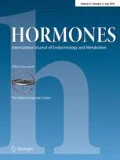Dear Editor
Isolated hypothyroidism as a primary cause of hypoglycemia is not a well-known phenomenon. The following case illustrates how isolated severe primary hypothyroidism can lead to symptomatic refractory hypoglycemia as a component of the myxedema crisis complex.
A 6-month-old female infant, born of a non-consanguineous marriage, was admitted with gross abdominal distension and history of chronic constipation. There was failure to thrive, and the infant’s weight was 3.3 kg (− 6 z score), length 51 cm (−6.97 z score), and head circumference 36 cm (− 5.13 z score).
She was born at full term, with a birth weight of 2 kg, by cesarean section because of oligohydramnios. Postnatally, she developed exaggerated unconjugated hyperbilirubinemia, which required phototherapy for 4 days. Global developmental delay was evident, as the infant had not achieved head control or social smile.
The infant was initially admitted to the surgical unit in view of her gaseous abdomen and to rule out intestinal obstruction. She received a barium enema, which revealed a nonobstructive, though sluggish intestinal transit. While in the ward, she became lethargic and mottled, with cool extremities and with hypotension, when she was found to have hypoglycemia (RBS-32 mg/dl). There was no clinical evidence of sepsis. She was transferred to pediatrics intensive care for stabilization. The child was markedly hypothermic and relatively bradycardic for the degree of hypotension. She required fluid boluses and dopamine infusion for hypotensive shock, glucose infusion (max 12.5 mg/kg/min), empirical intravenous hydrocortisone (50 mg/m2/day), and active warming. Chest X-ray revealed globular heart with increased hilar markings. Electrocardiogram showed low voltage complexes with normal rhythm. Cardiac contractility was poor, with low ejection fraction and a thin layer of pericardial effusion.
Clinical examination revealed that the child had coarse facies, pallor, umbilical hernia, open posterior fontanelle, and hypotonia with delayed relaxation of deep tendon reflexes. There was no organomegaly or corneal clouding. A thyroid profile was urgently sent for, which revealed severe primary hypothyroidism (free T3 (fT3) 0.49 pg/ml (2–4.4 pg/ml), free T4 (fT4) 0.03 ng/dl (0.8–1.8 ng/dl), thyroid-stimulating hormone (TSH) > 100 μIU/ml (0.45–4.5 μIU/ml)). Thyroid ultrasound revealed athyreosis of the gland. She was promptly started on oral thyroxine replacement at a dose of 10 μg/kg/day, with ongoing steroid cover.
The child also had severe macrocytic anemia (hemoglobin 6.4 g/dl, mean corpuscular volume 96 fl), for which she received a blood transfusion, and she was subsequently started on iron, folate, and vitamin B12 supplements. Total leucocyte and platelet counts were normal.
Meanwhile, evaluation of persistent hypoglycemia continued. Critical samples were sent at a blood glucose level of 23 mg/dl, which revealed no acidosis and no ketosis (serum beta-hydroxybutyrate negative). Serum electrolytes, ammonia (90 mmol/L (10–100)), and lactate (1.8 mmol/L) were normal. Serum cortisol was 29 μg/dl (5–25 μg/dl) and serum insulin was 0.5 μIU/ml, which were appropriate hormonal responses to the hypoglycemia. Urine for reducing substance was negative and tandem mass spectrometry was negative for any inborn errors of metabolism.
The infant required continuous milk infusion, with added corn starch and sugar for hypoglycemia management for a period of approximately 72 hours, amounting to maximum total carbohydrate loading of 84 g per day. Formal 2-D echo repeated 3 days post thyroxine replacement showed improved ejection fraction of 64% with mild Left Ventricular systolic dysfunction. fT4 levels repeated 2 weeks later showed normalization - 0.94 ng/dl (0.8–1.8). The child is now 2 years of age and has exhibited significant catch-up in growth and development.
The literature clearly highlights the importance of hypothyroidism as a precipitating factor for hypoglycemia [1]. Hypothyroidism is considered to be a cause of unexplained hypoglycemia in diabetics after exclusion of other causes. Rare case reports have previously described hypoglycemia secondary to primary hypothyroidism [2].
Severe hypothyroidism is linked to low growth hormone and cortisol responses to insulin-induced hypoglycemia, and this prevents adequate counter-regulatory protection. Pituitary dysfunction thus becomes a consequence of primary hypothyroidism rather than a cause of thyroid dysfunction. Hypothyroid patients may have relative adrenal insufficiency, with reduced adrenomedullary response to stress [3]. The processes of gluconeogenesis and glycogenolysis are also impaired in hypothyroidism, both in skeletal muscle and in adipose tissue. Other abnormalities in hypothyroidism include reduction in glucagon secretion, reduced effect of glucagon on hepatocytes, and slowing of insulin clearance [1]. Contributory factors also include the effect of hypothyroidism on the gastrointestinal system by slowing gastric emptying and decreasing intestinal absorption of glucose as well as portal venous flow.
The refractory hypoglycemia in the index patient was a component of the constellation of myxedema crisis. Decreased sympathetic drive was evident in our patient in the form of hypothermia and bradycardia in the form of hypotension.
The thyroid axis must not be neglected in the evaluation of persistent hypoglycemia, since isolated severe hypothyroidism may precipitate hypoglycemia in the absence of other pituitary or adrenal hormone deficiencies.
References
Shah JH, Motto GS, Papagiannes E, Williams GA (1975) Insulin metabolism in hypothyroidism. Diabetes 24:922–925
Yadav TC, Bhutani J, Upadhyay M, Raghunandan S (2017) Recurrent hypoglycemia: an unusual finding of hypothyroidism K. Thyroid Res Pract 14:127–129
Kamilaris TC, DeBold CR, Pavlou SN, Island DP, Hoursanidis A, Orth DN (1987) Effect of altered thyroid hormone levels on hypothalamic-pituitary-adrenal function. J Clin Endocrinol Metab 65:994–999
Author information
Authors and Affiliations
Corresponding author
Ethics declarations
Conflict of interest
The authors declare that they have no conflict of interest.
Additional information
Publisher’s note
Springer Nature remains neutral with regard to jurisdictional claims in published maps and institutional affiliations.
Rights and permissions
About this article
Cite this article
Sharma, S., Chandrashekhar, S.R. Refractory hypoglycemia in an infant with isolated severe primary hypothyroidism. Hormones 18, 329–330 (2019). https://doi.org/10.1007/s42000-019-00122-8
Received:
Accepted:
Published:
Issue Date:
DOI: https://doi.org/10.1007/s42000-019-00122-8

